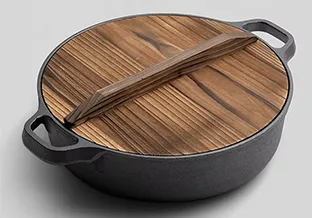
Exploring the Secrets of the Chinese Wok and Its Culinary Techniques
The Chinese Wok A Versatile Culinary Tool
The Chinese wok is an essential kitchen tool that has captivated the hearts and taste buds of food lovers across the globe. Known for its unique shape and versatility, the wok is more than just a cooking vessel; it is a symbol of Chinese culinary tradition and a conduit for flavor and texture in a myriad of dishes.
A Brief History
The origins of the wok can be traced back over 2,000 years to ancient China. Initially, it was designed for boiling and steaming food. However, as cooking techniques evolved, so did the wok. By the Han Dynasty, the wok became a staple in Chinese kitchens, suitable for various cooking methods, including frying, braising, and even baking. The traditional round-bottomed wok is particularly well-suited for stir-frying, a cooking method that focuses on high heat and quick movements to preserve the natural flavors and nutrients of the ingredients.
Design and Structure
The wok’s design is what sets it apart from other cooking pans. Typically made of carbon steel or cast iron, the wok is characterized by its rounded bottom and high, sloping sides. The round bottom allows for even heat distribution, which is crucial for quick cooking techniques that require high temperatures. The high sides help to contain food while stirring and tossing, making it easier to mix ingredients without spilling.
Modern woks come in various styles, including flat-bottomed versions suitable for electric stoves. However, traditionalists argue that the round-bottomed wok is the best for achieving the quintessential wok hei—the “breath of the wok” that imparts a unique smoky flavor to dishes.
Cooking Techniques
the chinese wok

One of the standout features of the wok is its versatility. It can be used for stir-frying, steaming, boiling, braising, and even deep-frying. When stir-frying, the high heat allows for quick cooking, sealing in the juices and flavors of the ingredients. A well-seasoned wok can reach high temperatures quickly, making it ideal for the quick cooking that defines many Chinese dishes.
The preparation of a typical stir-fry involves several steps heating the wok, adding oil, and quickly tossing in ingredients. The key to success lies in the timing and sequence of adding ingredients. Aromatics like garlic, ginger, and onions are often added first to infuse the oil before adding protein and vegetables. The quick cooking time allows for vibrant colors and textures, ensuring that vegetables retain their crunch and flavor.
Cultural Significance
The wok is not just a cooking tool; it represents a cultural phenomenon. In many Chinese households, cooking is a communal activity, often centered around the wok. Families gather to prepare meals, sharing stories and bonding over the experience. The act of cooking in a wok is viewed as an art form, where the cook’s skill can elevate simple ingredients into extraordinary meals.
Moreover, the wok has transcended its cultural boundaries, becoming a beloved tool in kitchens worldwide. Chefs and home cooks alike have embraced the versatility of the wok, incorporating it into various cuisines and adapting recipes to fit different palates.
Conclusion
In essence, the Chinese wok is a remarkable culinary tool that encapsulates the rich history and tradition of Chinese cooking. Its unique design and versatility allow for a variety of cooking methods, making it an indispensable part of any kitchen. Whether you are an experienced chef or a novice cook, mastering the use of a wok can open up a world of culinary possibilities, bringing the flavors of China right into your home. The wok is not just about cooking; it’s about embracing a tradition that celebrates the joy of food, family, and togetherness.
-
Season Cast Iron Perfectly with GPT-4 Turbo TipsNewsAug.01,2025
-
High Quality Cast Iron Cookware - Baixiang County Zhongda MachineryNewsAug.01,2025
-
Premium Cast Iron Pan: Durable & Perfect HeatNewsAug.01,2025
-
High Quality Kitchen Durable Black Round Cast Iron Cookware Pancake Crepe Pan-Baixiang County Zhongda Machinery Manufacturing Co., Ltd.NewsAug.01,2025
-
Cast Iron Cookware - Baixiang County Zhongda Machinery | Nonstick, Heat ResistanceNewsAug.01,2025
-
High Quality Kitchen Durable Black Round Cast Iron Cookware - Baixiang County Zhongda Machinery | Non-Stick, Heat Retention, DurableNewsJul.31,2025


